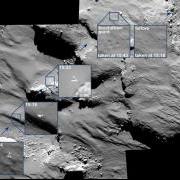In this month's Sky Notes:
- Planetary Skylights
- Meteor Activity
- Winter Solstice
- Philae: Touchdown... Touchdown... touchdown.
- November 2014 Sky Charts
Planetary Skylights
 Mars stubbornly lingers in the evening sky above the WSW horizon and doesn’t actually set until after 7pm. telescopically, it’s a case of ‘move along, nothing to see’, the disc being very small, but at least you can point it out to friends. The moon lies close by on the 24th & 25th.
Mars stubbornly lingers in the evening sky above the WSW horizon and doesn’t actually set until after 7pm. telescopically, it’s a case of ‘move along, nothing to see’, the disc being very small, but at least you can point it out to friends. The moon lies close by on the 24th & 25th.
 Jupiter is now rising well before midnight, a conspicuous presence across in the east by 9:30pm at the start of December and 8pm at the end, by which time it is well placed for observation. Telescopically, Jupiter is a wonderful spectacle with its attendant major moons and 'banded' disk, a real Christmas treat. After midnight Jupiter will be riding high to the south. The king of the planets actually resides just ahead of the ‘sickle asterism’ in Leo and not far from Regulus, its chief star. The moon lies near Jupiter and Regulus on the 9th.
Jupiter is now rising well before midnight, a conspicuous presence across in the east by 9:30pm at the start of December and 8pm at the end, by which time it is well placed for observation. Telescopically, Jupiter is a wonderful spectacle with its attendant major moons and 'banded' disk, a real Christmas treat. After midnight Jupiter will be riding high to the south. The king of the planets actually resides just ahead of the ‘sickle asterism’ in Leo and not far from Regulus, its chief star. The moon lies near Jupiter and Regulus on the 9th.

 During the last week of December first brilliant Venus and then elusive Mercury crawl up into the evening sky. Look for them low to the WSW horizon 45 minutes after sunset. Both will be better placed as we head into the New Year.
During the last week of December first brilliant Venus and then elusive Mercury crawl up into the evening sky. Look for them low to the WSW horizon 45 minutes after sunset. Both will be better placed as we head into the New Year.
 Finally Saturn returns to the early morning sky by mid December and is visible low to the ESE by 6:30am. The moon passes close by on the 19th and 20th. An early morning Christmas treat!
Finally Saturn returns to the early morning sky by mid December and is visible low to the ESE by 6:30am. The moon passes close by on the 19th and 20th. An early morning Christmas treat!
Meteor Activity

Meteor activity reaches a peak at this time of year and given clear skies the chance of spotting a shooting star or two should be quite high.
Considered now to be the most prolific annual meteor shower, the Geminids are active from December 7-16th, reaching a peak on December 14th. Unlike the majority of meteor showers, which are associated with comet debris, Geminids stem from debris shed by a strange object that may be a dead comet or small asteroid called Phaethon. This object passes within 10 million miles of the Sun and over time has deposited material over great swathes of the inner solar system. However it is only within the last 100 years that Geminid activity has increased to the levels recorded today with Earth passing through a much denser debris strand, a situation that will only last another 100 years!
The shower radiant lies close to Castor, the upper most of the 'twin' stars in Gemini visible in the east by 9pm. Under ideal conditions the Zenith Hourly Rate (ZHR) can reach well over 100, however observed rates are always substantially lower than this, so expect around 40 per hour during the early morning hours of the 14th. Really bright Geminids can sometimes appear green or orange in hue. Later in the month the Ursids (active Dec 17-25th) peak on Dec 22/23rd with hourly rates of 8-12 normal. Occasionally Ursids produce strong outbursts. The radiant lies close to the Great Bear.
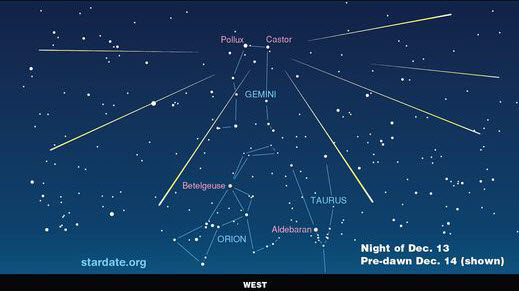
The Winter Solstice
Winter Solstice in Highlands
(Click image for full-size view)
We'd like to feature your photo:
please send them to us!
The Sun reaches its lowest position in the sky on December 21st this year; the date of the winter solstice, by which time the Sun arcs little more than 12 degrees above S horizon at local noon from our latitude.
With the northern hemisphere tilted away from the Sun, useful daylight then amounts to just 7½ hrs, the shortest day. Latest sunrise and earliest sunset do not however occur on the 21st. The Sun rises latest near the end of December (27 or 28th) and sets earliest mid-month (15th or 16th).
Astronomically speaking the winter solstice also marks the first day of winter in the northern hemisphere, but in a few weeks, daylight will once again start to lengthen in duration. Now that is cause for celebration! What shall we call it...mmm!.
Philae: Touchdown.... Touchdown... touchdown
Where did Philae get to?, OSIRIS
instrument spots Philae drifting
across the comet (Click image
for full-size view)
It’s been quite a while since a robotic lander mission caused such huge interest, even excitement amongst the general public, but the fortunes of Philae at comet 67P certainly did just that.
This was a drama played out over 300 million miles away with Ups and Downs a-plenty (certainly Philae experienced a few) and left us on the edge of our seats, with Philae near the edge of somewhere!
Approximately 8o% of the scientific program was completed, the results of which are still being analysed. What we do know is that Philae is now in hibernation mode, starved of sunlight to power the solar panels. Perhaps, as the comet heads into the inner solar system its orientation will alter, allowing sunlight to illuminate the location of Philae’s final resting place. We shall see in the coming months. I have a hunch the ride is not yet over!
For the latest on where Philae may finally have landed, mision news, science and even 3D images and movie-clips of the comet, join us on Tuesday 2nd December at 19:30h - 3D glasses supplied!
December 2014 Sky Charts
Click each image to see a full-size Sky Chart:
 |
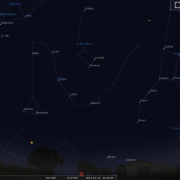 |
| Looking South Mid December - 21:00h |
Looking North |
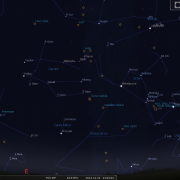 |
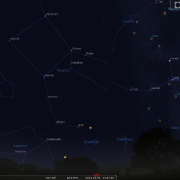 |
| Looking South-East Mid December - 21:00h |
Looking West Mid December - 19:45h |
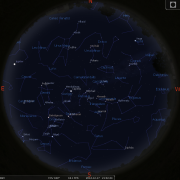 |
|
| Overview Mid-December - 21:00h |
Image Credits:
- Planets and Comets where not otherwise mentioned: NASA
- Position of Geminids: stardate.org
- Winter Solstice: © Sylvia Duckworth, licensed for reuse under this Creative Commons Licence
- Rosetta Mission: ESA
- Sky Charts: Stellarium Software
- Log in to post comments





